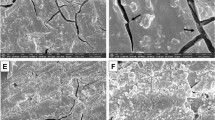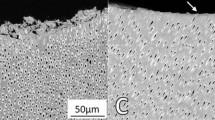Abstract
The aim of this article is to review the development of glass ionomer cements (GICs) over the last 40 years and look critically at both their clinical advantages and disadvantages. Primarily, it will explore the future development of both GICs and related ion-releasing materials in relation to improved mechanical properties, capability to prevent secondary caries and promoting remineralisation of hard carious dentine left after minimal cavity preparation procedures, including atraumatic restorative treatment. This article will also introduce new materials with a focus on degradable fluorine-containing glass fillers, including alkasite glasses and fluorine-containing bioactive glasses, that have the capability to raise the pH and promote remineralisation with the potential for fluorapatite formation.
Key points
Reviews the historical development of glass ionomer cements (GICs).
Explores the advantages and disadvantages of GICs.
Suggests potential ways GICs can be improved, notably for minimally invasive procedures such as autraumatic restorative therapy.
This is a preview of subscription content, access via your institution
Access options
Subscribe to this journal
Receive 24 print issues and online access
$259.00 per year
only $10.79 per issue
Buy this article
- Purchase on Springer Link
- Instant access to full article PDF
Prices may be subject to local taxes which are calculated during checkout




Similar content being viewed by others
References
Wilson A D, Kent B E. The glass-ionomer cement, a new translucent dental filling material. J Appl Chem Biotechnol 1971; 21: 313.
Wilson A D. Glass-ionomer cement - origins, development, future. Clin Mater 1991; 7: 275-282.
Smith D C. A new dental cement. Br Dent J 1968; 124: 381-384.
Smith D C. Improvements relating to surgical cements. British Patent Application GB1139430. 1969.
Towler M R. Bushby A J. Billington R W, Hill R G. A preliminary comparison of the mechanical properties of chemically cured and ultrasonically cured glass-ionomer cements using nano indentation techniques. Biomaterials 2001; 22: 1401-1406.
Frencken J E. The ART approach using glass-ionomers in relation to global oral health care. Dent Mater 2010; 26: 1-6.
Frencken J E. Pilot T, Songpaisan Y, Phantumvanit P. Atraumatic restorative treatment (ART): rationale, technique, and development. J Public Health Dent 1996; 56: 135-140.
Hill R.G, Warrens C P, Wilson A D. The influence of poly(acrylic acid) molecular weight on the fracture of glass ionomer cements. J Mater Sci 1989; 24: 363-371.
Wilson A D, Hill R G, Warrens C P, Lewis B G. The influence of polyacid molecular weight on some properties of glass ionomer cements. J Dent Res 1989; 68: 89-94.
Fennel B, Hill R G. The influence of poly(acrylic acid) molar mass and concentration on the properties of polyalkenoate cements: Part II Young's modulus and flexural strength. J Mater Sci 2001; 36: 5177-5183.
Mitra S B. Adhesion to dentin and physical properties of a light cured glass-ionomer liner/base. J Dent Res 1991; 70: 72-74.
Mitra S B. In vitro fluoride release from a light-cured glass ionomer liner/base. J Dent Res 1991; 70: 75-78.
Ellis J, Anstice M, Wilson A D. The glass polyphosphonate cement: a novel glass-ionomer cement based on poly(vinyl phosphonic acid). Clin Mater 1991; 7: 341-346.
Hill R G, Darling M. Novel polyalkenoate (glass-ionomer) cements based on zinc silicate glasses. Biomaterials 1994; 15: 299-306.
GC Corporation. Glass Powder for Dental Use. Patent WO/2017/168836. 2017.
GC Corporation. Cement for Dental Use. Patent WO/2017/168837. 2017.
Patil, K, Patel A, Kunte S, Shah P, Kaur B, Parrana S. Comparative Evaluation of the Mechanical Properties of Zinc-reinforced Glass Ionomer Cement and Glass Ionomer Type IX Cement: An In Vitro Study. Int J Clin Pediatr Dent 2020; 13: 381-389.
Liu Y, Kohno T, Tsuboi R et al. Antibacterial effects and physical properties of a glass ionomer cement containing BioUnion filler with acidity-induced ability to release zinc ion. Dent Mater J 2021; 40: 1418-1427.
Hasegawa T, Takenaka S, Ohsumi T et al. Effect of a novel glass ionomer cement containing fluoro-zinc-silicate fillers on biofilm formation and dentin ion incorporation. Clin Oral Investig 2020; 24: 963-970.
Hill R G, Wilson A D. Some structural aspects of glasses used in ionomer cements. Glass Technol 1988; 29: 150-158.
Duminis T, Shahid S, Karpukhina N G, Hill R G. Predicting refractive index of fluoride containing glasses for aesthetic dental restorations. Dent Mater 2018; DOI: 10.1016/j.dental.2018.01.024.
Hill R G, de Barra E, Griffin S et al. Ion release from glass polyalkenoate (ionomer) cements. Key Engineer Mater 1995; 100: 315-322.
Malik M. Investigation of effects of fluoride releasing dental materials on dentinal lesions treated using Atraumatic Restorative Technique 18 Month PhD Report. London: Queen Mary University of London, 2022. PhD Report.
De Caluwé T, Vercruysse C W J, Ladika I et al. Addition of bioactive glass to glass ionomer cements: Effect on the physico-chemical properties and biocompatibility. Dent Mater 2017; DOI: 10.1016/j.dental.2017.01.007.
Hench L L, Wilson J. An Introduction to Bioceramics. Singapore: World Scientific, 1993.
Todd J C. Scientific Documentation: Cention N. pp 1-58. Liechtenstein: Ivoclar-Vivadent Press, 2016.
Tiskaya M, Al-Eesa N A, Wong F S L, Hill R G. Characterization of the bioactivity of two commercial composites. Dent Mater 2019; 35: 1757-1768.
Abubacker M. Comparison of Clinical Efficiency of Cention - N (With and Without Adhesive) and Composite Resin (Tetric N Ceram Bulk Fill) as Class 1 Restorations: A Randomized Controlled Clinical Trial. Chennai: Tamil Nadu Government Dental College and Hospital, 2020. MSc Thesis.
Tiskaya M, Shahid S, Gillam D, Hill R. The use of bioactive glass (BAG) in dental composites: A critical review. Dent Mater 2021; 37: 296-310.
Al-Eesa N A, Diniz Fernandes S, Hill R G, Wong F S L, Jargalsaikhan U, Shahid S. Remineralising fluorine containing bioactive glass composites. Dent Mater 2021; 37: 672-681.
Par M, Gubler A, Attin T, Tarle Z, Tauböck T T. Anti-demineralizing protective effects on enamel identified in experimental and commercial restorative materials with functional fillers. Sci Rep 2021; DOI: 10.1038/s41598-021-91279-z.
Al-Eesa N A, Karpukhina N, Hill R G, Johal A, Wong F S L. Bioactive glass composite for orthodontic adhesives - Formation and characterisation of apatites using MAS-NMR and SEM. Dent Mater 2019; 35: 597-605.
Zain S, Davis G R, Hill R, Anderson P, Baysan A. Mineral exchange within restorative materials following incomplete carious lesion removal using 3D non-destructive XMT subtraction methodology. J Dent 2020; DOI: 10.1016/j.jdent.2020.103389.
Almaki A E A. X-ray microtomography study of Remineralisation of Carious Dentine left after Atraumatic Restorative Therapy (ART) using Bioactive Glass Composite Filling. London: Queen Mary University of London, 2016. MSc Thesis.
Author information
Authors and Affiliations
Corresponding author
Ethics declarations
The author is an inventor on the two granted fluoride bioactive glass patents WO 2011/000866 and WO 2011/161422 and owns shares in BioMin Technologies Ltd.
Rights and permissions
About this article
Cite this article
Hill, R. Glass ionomer polyalkenoate cements and related materials: past, present and future. Br Dent J 232, 653–657 (2022). https://doi.org/10.1038/s41415-022-4239-1
Received:
Accepted:
Published:
Issue Date:
DOI: https://doi.org/10.1038/s41415-022-4239-1
This article is cited by
-
Effect of a calcium silicate cement and experimental glass ionomer cements containing calcium orthophosphate particles on demineralized dentin
Clinical Oral Investigations (2024)
-
Herbalism and glass-based materials in dentistry: review of the current state of the art
Journal of Materials Science: Materials in Medicine (2023)
-
Modification of glass-ionomer cement properties by quaternized chitosan-coated nanoparticles
Odontology (2023)
-
Bioaktive Restaurationsmaterialien
Oralprophylaxe & Kinderzahnheilkunde (2023)



